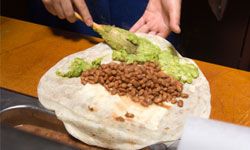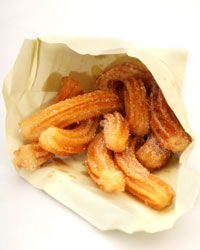“
 “Many city-dwellers turn to street food as a quick, delicious solution to lunch on the run. See more pictures of international snacks.©iStockphoto.com/eliandric
“Many city-dwellers turn to street food as a quick, delicious solution to lunch on the run. See more pictures of international snacks.©iStockphoto.com/eliandric
Packed with history and regional flair, street food is a culinary gem hidden in plain sight. These days, thanks to the pace of contemporary life, many of us are eating on the run. That’s where street food comes in — these delicious specialties are custom-made for high-speed living. As befits a nation of immigrants, we eat immigrant street food. The 10 street foods that follow were all born abroad but grew up stateside, and there’s a distinctly American twist to their fascinating stories. Read on to find out what part of a pizza is native to the New World and how a Jewish guy from Wisconsin made a Greek snack into a classic American street food.
Contents
- Falafel
- Hot Dogs
- Pizza
- Burritos
- Gyros
- Crêpes
- Ice Cream
- Churros
- Cotton Candy
- Soft Pretzels
10. Falafel
Grind up some chickpeas, add garlic, parsley and coriander, and fry until crunchy. According to some, it’s a recipe as old as the Bible. In all likelihood, it’s even older, having started out in Egypt as a dish made with fava beans. But even today, falafel’s origins are in dispute. Some Israelis claim it as an ancient Jewish food, while many Palestinians bristle at the idea. Cooler heads maintain that falafel is a regional delicacy, not a religious one. But politics are of little consequence when you’re standing on the sidewalk at lunchtime waiting for your favorite vendor to wrap some pita bread around a selection of pickled beets, tahini sauce, fresh veggies and, above all, crispy, delicious falafel.
9. Hot Dogs
 “
“ “Hot dogs are classic street fare. More mustard, please!©iStockphoto.com/Juanmonino
“Hot dogs are classic street fare. More mustard, please!©iStockphoto.com/Juanmonino
If you live in Chicago, it’s a beef frank and you eat it on a poppy seed roll with mustard, relish, onions, pickles, tomatoes and celery salt. If you’re in Rochester, N.Y., it’s a spicy pork sausage — split, grilled and nestled in a toasted bun. The varieties are as endless as the stories of its origins. Are they called franks because they were invented in Frankfurt, or are they called wieners because they come from Wien (aka Vienna)? Nobody knows for sure, but one thing’s certain: A hot dog’s not a hot dog until it’s sitting in a bun. And that important innovation is all-American.
8. Pizza
Archaeologists have dug ancient pizza ovens out of the ash of Pompeii in southern Italy. But the classic pizza that we’ve come to know and love wouldn’t exist without a little help from the New World. When the tomato was first brought to Europe from South America, the upper classes refused to eat it because they were convinced it was poisonous. But peasants were too poor to be picky, and they started spreading the red fruit on their pies. Several centuries later, fresh basil and mozzarella were added, and the classic pizza Margherita was born. Today, U.S. pizza toppings are as varied as the American palate. From pineapple to pickles, the only limit is your imagination.
7. Burritos
 “
“ “When you’re craving a burrito, you’ve got a hankering for a stuffed tortilla — not a little donkey.©iStockphoto.com/Joe_Potato
“When you’re craving a burrito, you’ve got a hankering for a stuffed tortilla — not a little donkey.©iStockphoto.com/Joe_Potato
Steamed or grilled, filled with beef or rice and beans, all burritos start with the same round, flat flour tortilla. They probably get their name from an old Spanish saying: "If I had a horse, I would go make my fortune, but I only have a little donkey." In Spanish, the word for "little donkey" is "burrito." Like its animal namesake, the burrito can carry anything: beans, rice, sour cream, cheese, avocados, chicken, beef, pork. You name it. In Sonora, Mexico, their likely birthplace, burritos are small, simple affairs, but over the decades, as burritos made their way north and west to their modern day capital, San Francisco, they grew in size and complexity until they became a great Mexican-American delicacy.
6. Gyros
The Greek word gyro means "spin," and that makes sense when you think of those huge cones of mystery meat spinning on their axes in sidewalk restaurants around the world. Before it became street fare, the gyro was popular long ago in Greece. Traditionally, these meat cones were made by hand from a combination of beef and lamb trimmings, breadcrumbs and oregano. Then, one day in Milwaukee in the early 1970s, a Jewish-American entrepreneur named (believe it or not) John Garlic was brainstorming with his wife Margaret when they dreamed up the idea of mass-producing that spinning meat. Voila — Old World met New World to create an enduring street-side favorite.
5. Crêpes
 “
“ “Crêpes come sweet or savory, making them perfect for breakfast, lunch, dinner and snacktime.©iStockphoto.com/Zeiss4Me
“Crêpes come sweet or savory, making them perfect for breakfast, lunch, dinner and snacktime.©iStockphoto.com/Zeiss4Me
Legend has it that in the 1930s, the great French chef Charpentier invented crêpes suzette with its signature orange sauce for the future King Edward VII of England. But long before that, it was the favorite food of French peasants. Originating in Brittany in northwest France with the simple ingredients of buckwheat flour, eggs, butter and milk, the crêpe has proven to be one of the most versatile foods ever created. Made on the spot by sidewalk vendors around the world and filled with everything from cheese and ham to strawberries and cream, crêpes are beloved by all.
4. Ice Cream
Frozen cream and sugar: simple, yet perfect. Was it invented in the 1600s in the court of Charles I, or even earlier by the Emperor Nero who sent slaves to fetch ice from the mountains? Actually, the historical record points to ancient China as the birthplace of the world’s favorite portable dessert. It was in 1774, on the eve of the American Revolution, that ice cream first arrived in the United States. But it took nearly another century before an ingenious New Jersey woman named Nancy Johnson invented a hand-cranked ice cream maker and America’s love affair with that miraculous confection took off. Chocolate or vanilla, scooped or soft-served, in a cone or a cup — maybe some of ice cream’s popularity is due to its versatility. After all, you can opt to sit down to an elaborate banana split concoction, or you can just walk down the sidewalk with a waffle cone and let your favorite flavor melt in your mouth.
3. Churros
 “
“ “Churros are a breakfast pastry with Latin flair.©iStockphoto.com/Maica
“Churros are a breakfast pastry with Latin flair.©iStockphoto.com/Maica
This delectable breakfast pastry owes its name to its unusual curvy shape. Once upon a time, Spanish shepherds stuck high in the mountains for days on end became desperate for a treat. Using the limited available ingredients of butter, eggs and flour, they concocted a fried pastry that resembled the horns of the sheep they tended. Those sheep were called churros. In time, that humble shepherds’ food made its way to Latin America and then north to the United States. In recent decades, Americans have taken to churros with gusto. Dusted with sugar and served with a steaming cup of hot chocolate, churros make an amazing sidewalk breakfast.
2. Cotton Candy
For hundreds of years, aristocrats savored delicate webs of sugar spun by elite chefs, but for regular people, that sweet, melt-in-your-mouth sensation was far too expensive. Then, in 1897, John C. Wharton and William Morrison invented a machine that melted and spun the sugar with ease. In 1904, they brought their machine to the St. Louis World’s Fair, where it was a huge success. In the 1970s, a further innovation fully automated the process all the way through packaging the confection in paper or plastic bags. Today, it’s hard to imagine a street fair without those pink, azure and ultramarine clouds of what used to be called fairy floss.
Did you know?
Is street food under threat? According to Consumers International, street food makes up nearly half of the developing world’s diet, yet globalization is eroding the regional variety of street food. If you love street food and want to protect its future, you can learn more at Street food.org.
1. Soft Pretzels
 “
“ “This famous Philly snack tastes best sprinkled with salt and smothered in mustard.©iStockphoto.com/MalevolentDust
“This famous Philly snack tastes best sprinkled with salt and smothered in mustard.©iStockphoto.com/MalevolentDust
In 610, a monk twisted some leftover dough into the shape of crossed arms and gave it to children as a reward for learning their prayers. Pretzels were a hit across Europe, and nine centuries later, when the Turks were tunneling under the walls of Vienna, it was the early-bird pretzel bakers who heard them and sounded the alarm. Even today, the coat of arms of the Viennese bakers proudly bears a pretzel. But it was the Pennsylvania Dutch who perfected what would become a famous Philly snack. According to The New York Times, the soft pretzel, sprinkled with salt and smothered in mustard may be the definitive street food.
Lots More Information
Related Articles
- 10 Coolest Summer Foods
- 10 Meals that Are Proven to Make You Happier
- Top 10 Picnic Foods
- How Pizza Works
- What are hot dogs made from?
Sources
- American Museum of Natural History. "Hot Dogs as America." April 30, 2009. (April 28, 2010).http://www.amnh.org/exhibitions/baseball/hotdogs/
- Churrisimo Café. "Traditional Spanish Foods" June 22, 2006. (April 28, 2010).http://www.churrisimo.com/churros_history.html
- Feiler, Bruce. "Spun Heaven." Gourmet Magazine. February 2000. (April 28, 2010). http://www.gourmet.com/magazine/2000s/2000/02/spunheaven
- Fox, Peter. "Burritos — A Search for Beginnings." Washington Post. April 11, 1998.
- Goldstein, Elaine Dann. " Fare of the Country; Philadelphia’s Twist on the Pretzel." The New York Times. Nov. 13, 1988. (April 28, 2010).http://www.nytimes.com/1988/11/13/travel/fare-of-the-country-philadelphia-s-twist-on-the-pretzel.html?sec=travel
- Gordan, Lucy. "The Pizza Connection." The Epicurean Traveler.com. May 2007. (April 28, 2010). http://www.epicureantraveler.com/articles/Pizza_History_Gordan/Pizza%20History_Gordan.html
- Kantor, Jodi. "A History of the Mideast in the Humble Chickpea." The New York Times. July 10, 2002. (April 28, 2010).http://www.nytimes.com/2002/07/10/dining/a-history-of-the-mideast-in-the-humble-chickpea.html?pagewanted=2
- Kraig, Bruce. "Hot Dog: A Global History." Reaktion Books, University of Chicago Press. 2009.
- Pappas, Lou Seibert. "Crêpes: Sweet & Savory Recipes for the Home Cook." Chronicle Books, 2006.
- Segal, David. " The Gyro’s History Unfolds." The New York Times. July 14, 2009. (April 28, 2010).http://www.nytimes.com/2009/07/15/dining/15gyro.html
- Street Food.org. "Serving Up Street food in the Global South." (April 28, 2010).http://street food.org/index.php?option=com_frontpage&Itemid=1
- University of Guelph. "Ice Cream History and Folklore." 1995. (April 28, 2010).http://www.foodsci.uoguelph.ca/dairyedu/ichist.html


